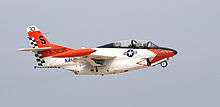North American T-2 Buckeye
The North American T-2 Buckeye was the United States Navy's intermediate training aircraft, intended to introduce U.S. Navy and U.S. Marine Corps student naval aviators and student naval flight officers to jets.[1] It entered service in 1959, and was replaced by the McDonnell Douglas T-45 Goshawk in 2008.[2]
| T-2 Buckeye | |
|---|---|
.jpg) | |
| A T-2C Buckeye from VT-9 | |
| Role | Jet trainer |
| National origin | United States |
| Manufacturer | North American Aviation North American Rockwell |
| First flight | 31 January 1958[1] |
| Introduction | November 1959[2] |
| Retired | United States Navy 2008[2] |
| Status | Active service with Hellenic Air Force |
| Primary users | United States Navy (historical) Hellenic Air Force Venezuelan Air Force (historical) |
| Produced | 1958–1970 |
| Number built | 529 |
Design and development
The first version of the aircraft entered service in 1959 as the T2J-1. It was redesignated the T-2A in 1962 under the joint aircraft designation system. The two-seat trainer was powered by one Westinghouse J34-WE-46/48 turbojet. The aircraft was subsequently redesigned, and the single engine was replaced with two 3,000 lbf (13,000 N) Pratt & Whitney J60-P-6 turbojets in the T-2B. The T-2C was fitted with two 2,950 lbf (13,100 N) thrust General Electric J85-GE-4 turbojets. The T-2D and T-2E were export versions for the Venezuelan Air Force and Hellenic Air Force, respectively. The T-2 Buckeye (along with the TF-9J Cougar) replaced the T2V-1/T-1A SeaStar, though the T-1 continued in some uses into the 1970s.

The Buckeye was designed as a low-cost, multistage trainer. Its straight wing was similar to that used on the FJ-1 Fury and its cockpit controls were similar to the propeller-driven T-28C Trojan. The T-2's performance was between that of the U.S. Air Force's Cessna T-37 Tweet and the U.S. Navy's TA-4J Skyhawk. While it had no built-in armament, the T-2 could accommodate two .50-inch gun pods, 100 lb (45 kg) practice bombs, or 2.75-inch rockets beneath the wings.
All T-2 Buckeyes were manufactured by North American at Air Force Plant 85, located just south of Port Columbus Airport in Columbus, Ohio. A total of 609 aircraft were built during the production run. The name Buckeye refers to the state tree of Ohio, as well as the mascot of The Ohio State University.
Every jet-qualified Naval Aviator and virtually every Naval Flight Officer from the late 1950s until 2004 received training in the T-2 Buckeye, a length of service spanning four decades. The aircraft first exited the Naval Aviator strike pipeline (where it saw its final carrier landings) in 2004,[3] and the Naval Flight Officer tactical jet pipeline in 2008. In the Naval Aviator strike pipeline syllabus and the Naval Flight Officer strike and strike fighter pipeline syllabi, the T-2 has been replaced by the near-sonic McDonnell Douglas T-45 Goshawk (the U.S. Navy version of the BAE Systems Hawk), which is more comparable to other high-performance, subsonic trainers, or the supersonic U.S. Air Force Northrop T-38 Talon.[4] More recently, the T-2 has been used as a director aircraft for aerial drones. Several T-2 Buckeyes, although still retaining their USN markings, are now registered as civilian-owned aircraft with FAA "N" numbers; they regularly appear at airshows.
Variants
- T-2A
- Two-seat intermediate jet training aircraft, powered by a 3,400-lb (1542-kg) thrust Westinghouse J34-WE-46/48 turbojet, original designation T2J-1 Buckeye, 217 built
- YT-2B
- Two T-2As were converted into T-2B prototype aircraft.
- T-2B
- Improved version, it was powered by two 3,000-lb (1360-kg) thrust Pratt & Whitney J60-P-6 turbojets; 97 were built.
- YT-2C
- One T-2B was converted into a T-2C prototype aircraft.
- T-2C
- Final production version for the U.S. Navy, it was powered by two 2,950-lbf thrust General Electric J85-GE-4 turbojets; 231 were built.
- DT-2B and DT-2C
- Small numbers of T-2Bs and T-2Cs were converted into drone directors.
- T-2D
- Export version for Venezuela, 12 built
- T-2E
- Export version for Greece, 40 built
Operators


%2C_left%2C_presents_the_last_T-2C_Buckeye.jpg)
Specifications (T-2C Buckeye)
Data from Jane's All The World's Aircraft 1976–77.[6]
General characteristics
- Crew: 2
- Length: 38 ft 3 1⁄2 in (11.671 m)
- Wingspan: 38 ft 1 1⁄2 in (11.621 m) (over tip tanks)
- Height: 14 ft 9 1⁄2 in (4.509 m)
- Wing area: 255 sq ft (23.7 m2)
- Airfoil: NACA 64A212
- Empty weight: 8,115 lb (3,681 kg)
- Max takeoff weight: 13,179 lb (5,978 kg)
- Fuel capacity: 691 US gal (575 imp gal; 2,620 L) total
- Powerplant: 2 × General Electric J85-GE-4 turbojets, 2,950 lbf (13.1 kN) thrust each
Performance
- Maximum speed: 453 kn (521 mph, 839 km/h) at 25,000 ft (7,600 m)
- Stall speed: 86.6 kn (99.7 mph, 160.4 km/h)
- Range: 909 nmi (1,046 mi, 1,683 km)
- Service ceiling: 40,400 ft (12,300 m)
- Rate of climb: 6,200 ft/min (31 m/s)
See also
Related development
Aircraft of comparable role, configuration and era
References
- "T-2 Buckeye". Boeing. Retrieved 16 March 2013.
- "Farewell, Buckeye!". defensetech.org. Archived from the original on August 14, 2008. Retrieved August 13, 2008.
- Gunsallus, U.S. Navy photo by Ens April (4 April 2004). "040409-N-1914G-002".
- "Archived copy" (PDF). Archived from the original (PDF) on 2010-07-14. Retrieved 2012-07-07.CS1 maint: archived copy as title (link)
- FAA Record for N27WS Archived 2012-02-17 at the Wayback Machine
- Taylor 1976, pp. 368–369.
- Taylor, John W. R. Jane's All The World's Aircraft 1976–77. London: Jane's Yearbooks, 1976. ISBN 0-354-00538-3.
External links
| Wikimedia Commons has media related to North American T-2 Buckeye. |